As the holiday season approaches, our to-do lists pile up with tasks. Pretty soon, you’re busy hanging the lights, rummaging through storage for decorations, and, most importantly, finding the perfect gifts to show friends and family how much they mean to you.
But what trends are influencing the season this year? According to the Dentsu US Consumer Navigator Report, the 2025 holiday landscape is in a state of flux, influenced by economic stress, evolving traditions, and the growing influence of AI-assisted shopping.
Let’s explore the 2025 holiday shopping trends and how they impact your holiday marketing strategies.
4 Holiday Shopping Trends for 2025
1. Budget Stress Takes Center Stage
Spending is now the top concern for 25% of consumers, nearly double the anxiety around gift selection. Financial pressure dominates holiday concerns at nearly double the rate of gift-finding anxiety (25% vs 14%). The fact that only 12% claim holidays are unstressful suggests we’ve reached peak holiday pressure

(Source)
Price is the deciding factor when choosing where to shop, outweighing convenience by a two-to-one margin (35% vs. 18%). While this year’s shoppers are clearly focused on their budgets, they still value unique products (34%) and great service (30%), showing that a good experience remains important.
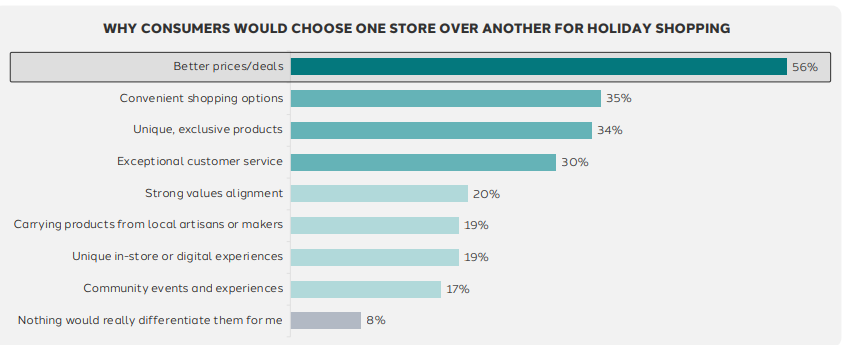
As a millennial, sticking to my budget can be a challenge, especially when the holiday nostalgia kicks in. Many holiday traditions come with a price tag: photos with Santa, ice skating, baking cookies, making crafts, and the list goes on. As a result, it’s understandable that the financial pressure can interfere with the magic and joy of the holidays for some consumers.

(Source)
Marketing Tip: Don’t just compete on price. Compete on value. Highlight durable gifts with unique features, and long-term utility to justify cost. Offer bundles or value-added services to make a purchase feel like a smart, budget-conscious decision.
FREE Audience Builder: Build Your Custom Holiday Audience Now
2. AI-Assisted Holiday Shopping
According to Dentsu’s research, AI adoption for the holidays remains consistent year-over-year (36% vs 38% in 2024), indicating the technology has moved past novelty into selective utility. Millennials lead adoption at 62%, and persistent gender gaps in AI use reflect broader tech adoption patterns.
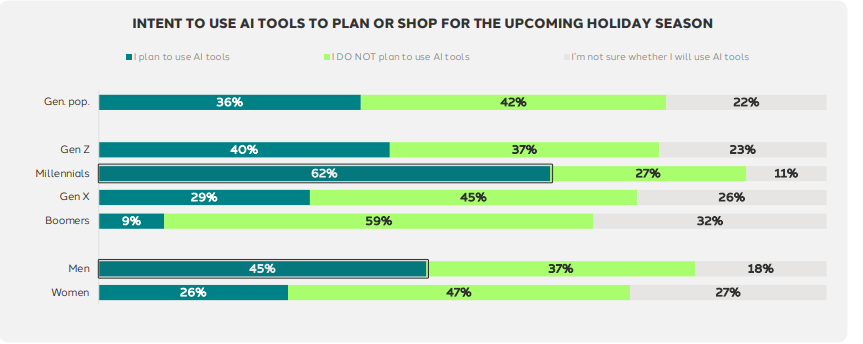
(Source)
A whopping 70% of consumers expect more AI-powered shopping tools this year, and 37% already encounter them frequently. However, only half rate these tools as “good” or “excellent,” revealing a gap between expectation and execution.

(Source)
Interestingly, 49% of AI users say they’d appreciate a gift more if it were chosen by AI, but 52% would keep that fact a secret. This “AI gift paradox” underscores a lingering discomfort with technology’s role in personal relationships—even as its utility grows.
Holiday Tasks AI Users are Interested in AI Supporting
When it comes to the tasks consumers want AI to handle, there’s been a clear shift. Personalized product recommendations jumped from fifth to first place in just one year, while AI-powered customer service and meal planning also saw significant gains. This suggests that consumers are ready for AI to move beyond simply providing information and become more deeply integrated into their purchasing decisions.
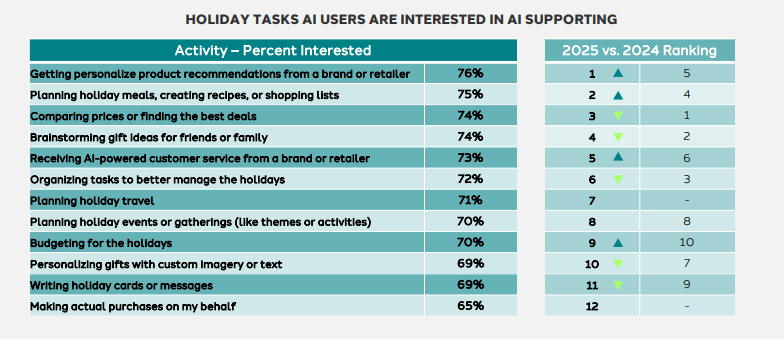
(Source)
Marketing Tip: Use AI as a behind-the-scenes co-pilot, not a centerpiece. Use AI to hyper-personalize recommendations, but focus your messaging on the human-centered outcome: the perfect gift, a faster shopping journey, and a more joyful experience.
3. Physical Gifts Still Rule
Digital gifting continues to rise, but physical gifts still rule. Consumers are leaning toward practical, everyday-use items (41%) and personalized products (35%), reflecting a desire for utility and thoughtfulness over indulgence.
For example, last year my family gifted one another kitchen appliances, tools, and items for our homes.
Older generations are more likely to stick with traditional physical gifts, while the younger gift-givers want a blend of physical and digital.
Marketing Tip: Lean into the demand for practical and personalized items. Use consumer data to create personalized gift guides and marketing campaigns that showcase useful, thoughtful additions for your audience.
4. Consumers are Embracing Joy and New Holiday Traditions
What do people want most this holiday season? Despite financial stress, consumers are most focused on finding joy this holiday season. This desire is strongest among older generations, while millennials are more likely to seek productivity and inspiration—perhaps due to their life stage.

(Source)
As far as holiday traditions go, most consumers are balancing a respect for the past with the realities of the present. They are keeping their core traditions while letting go of the ones that no longer serve them. While 34% of consumers will fully embrace all traditional activities, nearly one in four are keeping some traditions but creating new ones.
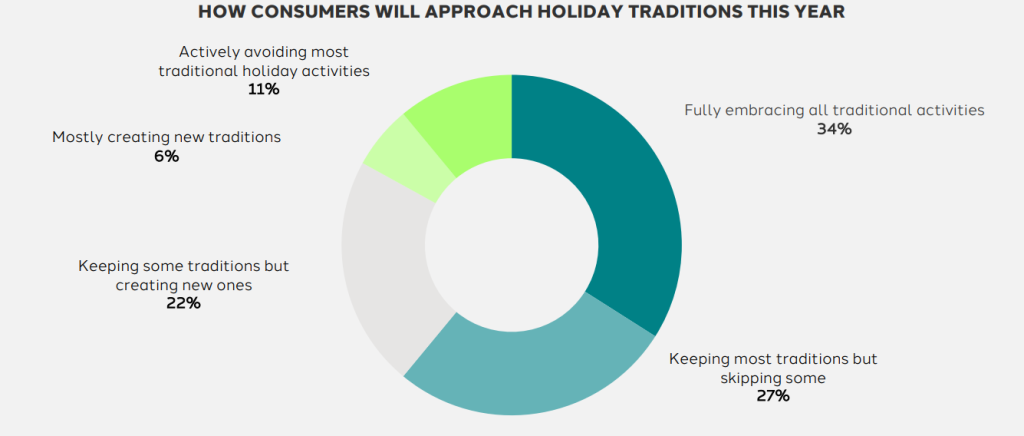
(Source)
A significant two in five consumers are interested in celebrating non-traditional holidays like the viral “Summerween,” creating a clear opportunity for brands to forge new traditions. This trend is particularly strong among Millennials (68%) and Gen Z (54%), as well as nearly half of men (49%).
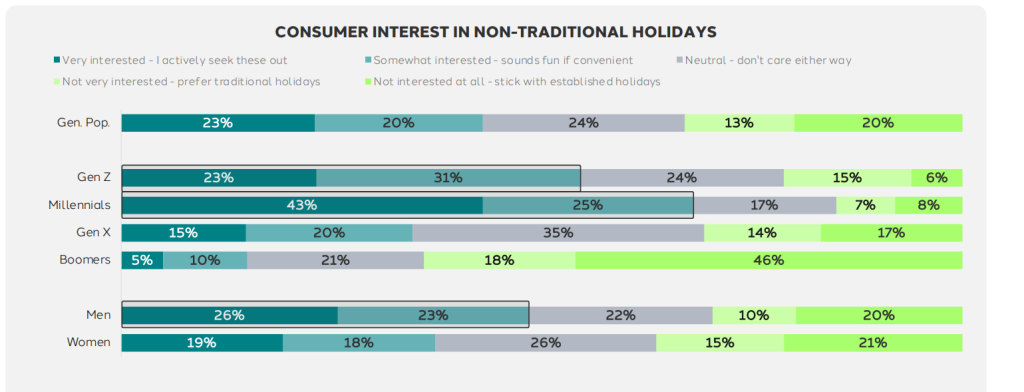
Marketing Tip: Market for joy, not stress. Frame your products as a way for consumers to create new traditions and rituals. Highlight how your offerings can be a part of fresh, meaningful celebrations to appeal to those looking for a new take on the holidays.
Final Thoughts
So, what’s the big takeaway for holiday marketing this year? It all comes down to a delicate balancing act.
Consumers are trying to find the magic of the season without adding to their financial stress. They’re also wrestling with new realities, like AI, and reimagining old traditions to fit their lives now. For marketers, this isn’t a challenge—it’s an invitation to become a true partner in their holiday journey.
The goal of your marketing this year isn’t just to sell a product; it’s to help your audience find the perfect gift that feels both practical and thoughtful.

